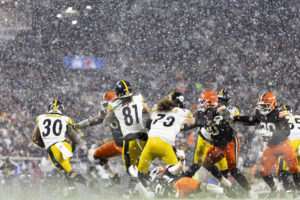Losing two games in a row, the Kansas City Chiefs are playing on Monday Night Football not only to defend Arrowhead Stadium and their AFC West lead, but to protect their core identity. Psychologically, there is no better team to poignantly ‘get-right’ than division rival Denver Broncos. Rivalry matchup aside, the Broncos also present a prime opponent to play chess against. Between the Broncos usually hard-nosed defense, and their propensity to grind the clock via running, the Chiefs defense and offense can return to the right way of Chiefs football. Andy Reid ought to prepare a plan that forces Trevor Siemian into bad passes, while offensively planning more risks with Tyreek Hill and Travis Kelce. The Kansas City Chiefs week eight scheme is about getting on the high horse of intelligent offensive scheme with equally physical defensive prowess.
Kansas City Chiefs Week Eight Scheme Breakdown – Back on the High Horse
Shock and Awe
Reid has been a genius at setting up opportune, perceptually ‘risky’ plays. Even in the loss to the Oakland Raiders, the Chiefs had an excellent plan of attack for 55 minutes until the offensive line gave way for their sole sack. Using similar tactics, the Chiefs can overcome one of the better NFL defenses. But, it must begin with a shock from Kareem Hunt.
The Chiefs run game epitomizes the defining strategy of their 2017 operation. Besides being efficient, the Chiefs are a team defined by confusing defenses through run formation precedents. Defenses will lean toward run, then get burned on play-action, the implication being the Broncos defense can fall victim to their own best unit.
Starting with a run, then following that with a play-action pass to Kelce might be exactly how Reid inserts the shock on drive one. Without the physicality of safety T.J. Ward, tight ends are now able to split the Broncos seam and focus on getting into empty zones. Evan Engram and Hunter Henry have both epitomized bringing the fight to the secondary. Now its Kelce’s turn.
Bringing the shock and awe directly to the Broncos is a daring plan, a chess move with the necessitation of calculation. The Chiefs will be entering uncharted territory with their fully functional litany of deep targets. In 2016, Smith only attempted three deep passes on the Broncos in their two games; one was completed to Kelce for 21 yards. In 2015, Smith attempted five deep passes with one completion to Jeremy Maclin.
The recent difficulty of deep passes on the Broncos revolved around Wade Phillips (still utilized past his departure) introducing a blitz-first, cooperative assignment system with the cornerback. The talent of Aqib Talib and Chris Harris was combined with Von Miller to create a defense capable of blitzing in any gap and defending passes from any range.
Compared to other teams, the Broncos have safeties who will be more comfortable lining up on Hill or Albert Wilson spread wide. The multiple concept packages that Reid typically inserts will be met with a level of prose few other teams have, implication being the run game needs to force the Broncos into alignment discomfort.
Furthermore, the defensive line creates false pressure without the blitz. Ideally, Miller or Brandon Marshall would show blitz, forcing the center to focus protection at the pending blitz. However, Shane Ray or Derek Wolfe would come off the edge as Miller stayed in coverage.
The mere focus on the potential of blitz confused veteran lines and isolated rookie lineman on an island. Subsequently, quarterbacks would lose sight of the linebacker who dropped into shadow coverage, attempted a check pass only to have that linebacker or one of the safeties step-up for a timely interception.
Unfortunately for the Broncos, the ideal scheme has not existed in 2017. Defensive ends Ray and Jared Crick are on injured reserve, and linebacker Todd Davis is out until further notice. While Miller has landed an impressive seven sacks, Wolfe only has one with Shelby Harris tallying another two.
Nevertheless, the Broncos defense is still phenomenal allowing a meager 4.5 yards per play. As described before, Reids build the strategy. Pointing back to the run game, the offensive line will need to keep linebackers out of the backfield long enough for Hunt to attain foresight on where holes are developing.
After establishing run formations as successful, the Broncos will not be as likely to show blitz, moving their safeties further inward. This unlocks the ingenuity of Reid; as linebackers need to respect the interior of the field, motioning Hill or Wilson transitions coverage onto them, opening one side of the field due to commitment. That commitment reverses the tricks the Broncos play, and forces a less trained safety or linebacker to pick up Kelce or Demetrius Harris as their routes go away from the strength of the defense.
The above is a description of one concept Reid can use, but this is how the Chiefs beat the Broncos. Establishing momentum in the short-field early may offer the deep ball a shining moment. However, recall in the two 2016 victories over the Broncos, Kelce has 261 yards of receiving and a touchdown – all yards garnered from targets to the short cones.
Behind Enemy Lines
Finding a way to get into the backfield, behind enemy lines, and disrupt Siemian is not only important for this game, but an important part of developing the remainder of the season. The Chiefs lack of a pass rush from Dee Ford, Justin Houston, or the interior is inexcusable. Dave Toub and the front office has evolved a defense around generating pressure, and when that pressure does not exist, the entire strategy collapses.
Problematic is not the 13 sacks – a middle mark in the NFL – but the lack of pressure late in games. The sacks came early in games, then were bottled in the second half. The Broncos have given up 22 sacks on the year, providing ample opportunity for the Chiefs to bounce back after a long week of rest.
Facing the Broncos offense is more about the Chiefs executing their strategy and forcing Siemian and offensive coordinator Mike McCoy to play according to the Chiefs will. Siemian is a managerial quarterback and extremely cerebral. Those high intangibles, however, are also his worst enemy due to paralysis by analysis.
Discomfort forces Siemian into quick choices without the comfort of timing to perceive. His eight touchdowns are met with seven interceptions. Playing from behind demands passing and risk, and Siemian simply cannot operate in risk.
The ideal coming into the season was utilizing Jamaal Charles and C.J. Anderson on wheel routes, combined with repeated running by Anderson, and then over the top slam dunks on behalf of the refined technique in Demaryius Thomas and Emmanuel Sanders. Charles is most likely dreaming about coming back to burn his former team, but with only eight receptions and Anderson adding only 14, the assumed plan is effectively dead.
Pounding the ball with Anderson has evolved into the effective strategy for the Broncos. In their wins, Anderson has been able to pound defenses at will for 81, 118, and 95 yards. In losses, Anderson has limped to 36, 17, and 44 yards. The implication is high volume begets clock control, and clock control begets only a matter of time before Thomas or Sanders can spring to secure the victory.
Keeping the initial plan dead, again, revolves to generating pressure. Toub operates a system that relies on pressure to assist aptly termed ‘dinner plate’ corners. The dinner-plate term comes as the corners play back on receivers until they meet for a physically imposing battle late in the route. The blitz prevents Marcus Peters and Terrance Mitchell from having to lose their receivers, but without that pressure, quarterbacks can time their routes. Thus, Peters and Mitchell are (and have been) left a step too late.
Thomas and Sanders then are the most potent threat against the Chiefs. Thomas is one of the most refined technicians at receiver in the NFL. Just as Antonio Brown and Amari Cooper burned the Chiefs, Thomas and Sanders will attempt the same. By running exterior routes to the sideline, corners will be isolated on an island where safeties cannot reach for help.
Although the perception of Siemian is a lack of refined touch, in the November 27, 2016 game, Sanders caught seven passes for 162 yards. Five of seven deep passes (219 yards) put Siemian on the way for 368 yards and a three-touchdown game. All of this occurred as Siemian was sacked five times; both Mitchell and Peters are too good to let this occur again.
The effort needed from Peters and Mitchell ought to be that of the Christmas evening game; a 33-10 Chiefs victory that saw a depleted Broncos team throw an egregiously high 43 times for 17 completions and only 183 yards. Although no sacks were landed, the defense finished. The defense was mentally behind the Broncos line.
Summarizing the Plan of Attack
Offensively, Reid will need to venture where he has not ventured before – attacking the Broncos deep. There may only be one or two attempts, but they need to be effective. Beginning with a shocking run game, and then flipping the Broncos defense to target Kelce, the Chiefs can continue their precise offensive format.
On defense, the Chiefs need to operate behind enemy lines, not only tangibly, but in mentality. Getting into the heads of the coaching staff and Siemian will result in poor decision making, forcing the Broncos to play into the Chiefs hands. Conceptually, setting that tone begins with sacks, and ends with Peters and Mitchell landmarking their own islands.
Main Image:






